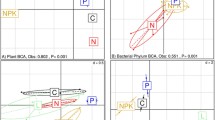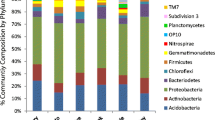Abstract
Many studies have shown effects of plants species on fungal communities, but these are often confounded with soil effects. Thus, the specific role of plant species in structuring rhizospheric and soil fungal communities is poorly described. Our study used microcosms in which plants were grown under artificial conditions to bridge this gap. Two perennial grasses dominating subalpine grasslands, Festuca paniculata and Dactylis glomerata, were grown at two levels of fertilization on standard soil. Fungal communities were determined by 454 pyrosequencing of the internal transcribed spacer 1 region. Among the fungal communities characterized by the primers used, original communities were associated to each plant species and also diverged between rhizosphere and bulk soils within each plant species, though there were no significant fertilization effects. Differences regarded global composition of the fungal communities and abundant molecular operational taxonomic units (MOTUs). Both plant species and location effects were reflected more in the abundance than in the composition of MOTUs. The observed differences in fungal communities coincide with differing strategies of plant root growth, with D. glomerata having greater root mass, length, and area than F. paniculata. Our study, by dissociating soil effects from plant effects, demonstrated that plant species exert a key control on soil fungi. We suggest that such effects may be linked to inter-specific differences in root traits and their consequences on nitrogen uptake.



Similar content being viewed by others
References
Abarenkov K, Nilsson R, Larsson KH, Alexander I, Eberhardt U, Erland S et al (2010) The UNITE database for molecular identification of fungi—recent updates and future perspectives. New Phytol 186:281–285
Akiyama H, Hayashi H (2006) Strigolactones: chemical signals for fungal symbionts and parasitic weeds in plant roots. Ann Bot 97:925–931
Allison SD, Hanson CA, Treseder KK (2007) Nitrogen fertilization reduces diversity and alters community structure of active fungi in boreal ecosystems. Soil Biol Biochem 39:1878–1887
Anderson MJ (2001) A new method for non-parametric multivariate analysis of variance. Aust Ecol 26:32–46
Arfi Y, Buée M, Marchand C, Levasseur A, Record E (2012) Multiple markers pyrosequencing reveals highly diverse and host-specific fungal communities on the mangrove trees Avicennia marina and Rhizophora stylosa. FEMS Microbiol Ecol 79:433–444
Bais HP, Weir TL, Perry LG, Gilroy S, Vivanco JM (2006) The role of root exudates in rhizosphere interactions with plants and other organisms. Annu Rev Plant Biol 57:233–266
Bardgett RD, Lovell RD, Hobbs PJ, Jarvis SC (1999) Seasonal changes in soil microbial communities along a fertility gradient of temperate grasslands. Soil Biol Biochem 31:1021–1030
Berg G, Smalla K (2009) Plant species and soil type cooperatively shape the structure and function of microbial communities in the rhizosphere. FEMS Microbiol Ecol 68:1–13
Bertin C, Yang X, Leslie WA (2003) The role of root exudates and allelochemicals in the rhizosphere. Plant Soil 256:67–83
Bezemer TM, Lawson CS, Hedlund K, Edwards AR, Brook AJ, Igual JM, Mortimer SR, Van Der Putten WH (2006) Plant species and functional group effects on abiotic and microbial soil properties and plant–soil feedback responses in two grasslands. J Ecol 94:893–904
Bouasria A, Mustafa T, De Bello F, Zinger L, Lemperiere G, Geremia RA, Choler P (2012) Changes in root-associated microbial communities are determined by species-specific plant growth responses to stress and disturbance. Eur J Soil Biol 52:49–66
Bray JR, Curtis JT (1957) An ordination of the upland forest communities of southern Wisconsin. Ecol Monogr 27:325–349
Broeckling CD, Broz KA, Bergelson J, Daniel K, Manter DK, Vivanco JM (2007) Root exudates regulate soil fungal community composition and diversity. Appl Environ Microbiol 74:738–744
Cesco S, Mimmo T, Tonon G, Tomasi N, Pinton R, Terzano R, Neumann G, Weisskopf L, Renella G, Landi L, Nannipieri P (2012) Plant-borne flavonoids released into the rhizosphere: impact on soil bio-activities related to plant nutrition. Rev Biol Fertil Soils 48:123–149
Clark RB, Zeto SK (2000) Mineral acquisition by arbuscular mycorrhizal plants. J Plant Nutr 23:867–902
Cornelissen JHC, Aerts R, Cerabolini B, Werger MJA, van der Heijden MGA (2001) Carbon cycling traits of plant species are linked with mycorrhizal strategies. Oecologia 129:611–619
Costa R, Götz M, Mrotzek N, Lottmann J, Berg G, Smalla K (2006) Effects of site and plant species on rhizosphere community structure as revealed by molecular analysis of microbial guilds. FEMS Microbiol Ecol 56:236–249
De Deyn GB, Quirk H, Bardgett RD (2011) Plant species richness, identity and productivity differentially influence key groups of microbes in grassland soils of contrasting fertility. Biol Lett 7:75–78
De Ridder-Duine AS, Kowalchuk GA, Klein Gunnewiek PJA, Smant W, van Een JA, de Boer W (2005) Rhizosphere bacterial community composition in natural stands of Carex arenaria (sand sedge) is determined by bulk soil community composition. Soil Biol Biochem 37:349–357
Donnison LM, Gwyn S, Hedgerb GJ, Hobbsc PJ, Bardgett RD (2000) Management influences on soil microbial communities and their function in botanically diverse haymeadows of northern England and Wales. Soil Biol Biochem 32:253–263
Epp L, Boessenkool S, Bellemain EP, Haile J, Esposito A, Riaz T et al (2012) New environmental metabarcodes for analysing soil DNA: potential for studying past and present ecosystems. Mol Ecol 21:1821–1833
Falkowski PG, Fenchel T, Delong EF (2008) The microbial engines that drive Earth’s biogeochemical cycles. Science 320:1034–1039
Ficetola GF, Coissac E, Zundel S et al (2010) An in silico approach for the evaluation of DNA barcodes. BMC Genomics 11:434
Fog K (1988) The effect of added nitrogen on the rate of decomposition of organic matter. Biol Rev 63:433–462
Frey SD, Knorr M, Parrent JL, Simpson RT (2004) Chronic nitrogen enrichment affects the structure and function of the soil microbial community in temperate hardwood and pine forests. For Ecol Manag 196:159–171
Gransee A, Wittenmayer L (2000) Qualitative and quantitative analysis of water-soluble root exudates in relation to plant species and development. J Plant Nutr Soil Sci 163:381–385
Grayston SJ, Wang S, Campbell CD, Edwards AC (1998) Selective influence of plant species on microbial diversity in the rhizosphere. Soil Biol Biochem 30:369–378
Helgason T, Merryweather JW, Denison J, Wilson P, Young JPW, Fitter AH (2002) Selectivity and functional diversity in arbuscular mycorrhizas of co-occurring fungi and plants from a temperate deciduous woodland. J Ecol 90:371–384
Innes L, Hobbs PJ, Bardgett RD (2004) The impacts of individual plant species on rhizosphere microbial communities in soils of different fertility. Biol Fertil Soil 40:7–13
Jumpponen A, Jones KL, David Mattox J, Yaege C (2010) Massively parallel 454-sequencing of fungal communities in Quercus spp. ectomycorrhizas indicates seasonal dynamics in urban and rural sites. Mol Ecol 19:41–53
Kruskal W, Wallis A (1952) Use of ranks in one-criterion variance analysis. J Am Stat Assoc 47:583–621
Lavorel S, Grigulis K, Lamarque P, Colace MP, Garden D, Girel J, Douzet R, Pellet G (2011) Using plant functional traits to understand the landscape-scale distribution of multiple ecosystem services. J Ecol 99:135–147
Lekberg Y, Koide RT, Rohr JR, Aldrich-Wolfe L, Morton JB (2007) Role of niche restrictions and dispersal in the composition of arbuscular mycorrhizal fungal communities. J Ecol 95:95–105
Lekberg Y, Meadow J, Rohr JR, Redecker D, Zabinski CA (2011) Importance of dispersal and thermal environment for mycorrhizal communities: lessons from Yellowstone National Park. Ecology 92:1292–1302
Lentendu G, Zinger L, Manel S, Coissac E, Choler P, Geremia RA, Melodelima C (2011) Assessment of soil fungal diversity in different alpine tundra habitats by means of pyrosequencing. Fungal Divers 49:113–123
McArdle BH, Anderson MJ (2001) Fitting multivariate models to community data: a comment on distance-based redundancy analysis. Ecology 82:290–297
Millard P, Singh BK (2010) Does grassland vegetation drive soil microbial diversity? Nutr Cycl Agroecosyst 88:147–158
Mouhamadou B, Molitor C, Baptist F, Sage L, Clément JC, Lavorel S, Monier A, Geremia RA (2011) Differences in fungal communities associated to Festuca paniculata roots in subalpine grasslands. Fungal Divers 47:55–63
Needleman SB, Wunsch CD (1970) A general method applicable to the search for similarities in the amino acid sequence of two proteins. J Mol Biol 48:443–453
Oksanen J, Kindt R, Legendre P, O’Hara B, Gavin L (2009) vegan: Community Ecology Package. R package version 1.15–4
Pakeman RJ (2011) Multivariate identification of plant functional response and effect traits in an agricultural landscape. Ecology 92:1353–1365
Pearson WR (2000) Flexible sequence similarity searching with the FASTA3 program package. Methods Mol Biol 132:185–219
Personeni E, Nguyen C, Marchal P, Pages L (2007) Experimental evaluation of an efflux–influx model of C exudation by individual apical root segment. J Exp Bot 58:2091–2099
Phillips JM, Hayman DS (1970) Improved procedure for clearing roots and staining parasitic and vesicular–arbuscular mycorrhizal fungi for rapid assessment of infection. Trans Br Mycol Soc 55:158–163
Rillig MC, Mummey DL (2006) Mycorrhizas and soil structure. New Phytol 171:41–53
Schnoor TK, Lekberg Y, Rosendahl S, Olsson PA (2011) Mechanical soil disturbance as a determinant of arbuscular mycorrhizal fungal communities in semi-natural grassland. Mycorrhiza 21:211–220
Singh BK, Bardgett RD, Smith P, Reay DS (2010) Microorganisms and climate change: terrestrial feedbacks and mitigation options. Nat Rev Microbiol 8:779–790
Standing D, Killham K (2007) The soil environment. In: Van Elsas JD, Jansson JK, Trevors JT (eds) Modern soil microbiology, 2nd edn. CRC, Boca Raton, pp 1–21
Steinkellner S, Lendzemo V, Langer I, Schweiger P, Khaosaad T, Toussaint JP, Vierheilig H (2007) Flavonoids and strigolactones in root exudates as signals in symbiotic and pathogenic plant–fungus interactions. Molecules 12:1290–1306
Trouvelot A, Kough JL, Gianinazzi-Pearson V (1986) Mesure du taux de mycorhization VA d’un système radiculaire. Recherche de méthodes ayant une signification fonctionnelle. In: Gianinazzi-Pearson V, Gianinazzi S (eds) Physiological and genetical aspects of mycorrhizae. INRA, Paris, pp 217–221
Turnau K, Haselwandter K (2002) Arbuscular mycorrhizal fungi: an essential component of soil microflora in ecosystem restoration. In: Gianinazzi S, Schuepp H (eds) Mycorrhizal technology: from genes to bioproducts. Birkhauser, Basel, pp 137–149
van der Heijden MGA, Bardgett RD, van Straalen NM (2008) The unseen majority: soil microbes as drivers of plant diversity and productivity in terrestrial ecosystems. Ecol Lett 11:296–310
van Dongen S (2000) Graph clustering by flow simulation. Ph.D. thesis, University of Utrecht
Wardle DA, Barker GM, Bonner KI, Nicholson KS (1998) Can comparative approaches based on plant ecophysiological traits predict the nature of biotic interactions and individual plant species effects in ecosystems? J Ecol 86:405–420
Wardle DA, Bardgett RD, Klironomos JN, Setala H, Wim H, van der Putten WH, Wall DH (2004) Ecological linkages between aboveground and belowground biota. Science 304:1629–1633
White TJ, Bruns T, Lee S, Taylor J (1990) PCR protocols: a guide to methods and applications. Academic, New York
Zinger L, Lejon DPH, Baptist F, Bouasria A, Aubert S, Geremia RA, Choler P (2011) Contrasting diversity patterns of crenarchaeal, bacterial and fungal soil communities in an alpine landscape. PLoS One 6:e19950
Acknowledgments
This research was conducted on the long-term research site Zone Atelier Alpes, a member of the ILTER-Europe network. The authors are grateful to Nael Mouhamadou and Viviane Barbreau for their help, reading, and kind comments. The authors would like to thank A.F. Ameline, A.S. Desfeux, J. Bonnefoy, and R. Ségura for technical assistance. This study was conducted as part of ERA-Net BiodivERsA project VITAL, ANR-08-BDVA-008.
Author information
Authors and Affiliations
Corresponding author
Electronic supplementary material
Below is the link to the electronic supplementary material.
ESM 1
(DOCX 246 kb)
Rights and permissions
About this article
Cite this article
Mouhamadou, B., Puissant, J., Personeni, E. et al. Effects of two grass species on the composition of soil fungal communities. Biol Fertil Soils 49, 1131–1139 (2013). https://doi.org/10.1007/s00374-013-0810-x
Received:
Revised:
Accepted:
Published:
Issue Date:
DOI: https://doi.org/10.1007/s00374-013-0810-x




